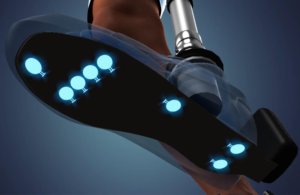
Prosthesis with neurofeedback sensors [Image from ETH Zurich]
Researchers at ETH Zurich have developed a prosthesis system that connects to the body’s nervous system to help amputees perceive a prosthetic weight as lower.
The prosthesis system provides feedback to the wearer using electrodes implanted in the thigh that are connected to the leg nerves. Information from the tactile sensors under the sole of the prosthetic foot and angle sensors in the electronic prosthetic knee joint are then converted into pulses of current and passed into the nerves, according to the researchers.
“To trick an above-knee amputee’s brain into the belief that the prosthetic leg was similar to his own leg, we artificially restored the lost sensory feedback,” lead researcher Stanisa Raspopovic said in a news release.
The researchers suggest that wearers of neurofeedback prostheses can move more safely and with less effort. The study also showed that neurofeedback reduced the perceived weight of prostheses.
In the study, the researchers used voluntary study participants to complete gait exercises with either neurofeedback switched on or off to determine how heavy a transferal amputee could perceive their prosthetic leg. The researchers weighed down the healthy foot with weights and asked the participants to rate how heavy each leg felt in relation to each other.
Neurofeedback reduced the perceived weight of the prosthesis by 23%, or almost 500 grams, according to the study. The researchers also confirmed a beneficial involvement of the brain by the motor-cognitive task when study participants had to spell five-letter words backward while walking. Sensory feedback allowed participants to have a faster gait and higher spelling accuracy.
“Neurofeedback not only enables faster and safer walking and positively influences weight perception,” said Raspopovic. “Our results also suggest that, quite fundamentally, it can take the experience of patients with an artificial device closer to that with a natural limb.”
The research was published in the journal Current Biology.